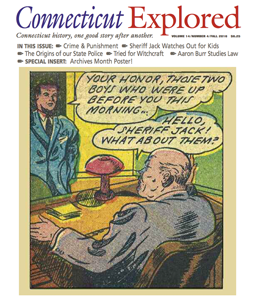By Elizabeth J. Normen
(c) Connecticut Explored Inc. Fall 2016
Our Puritan forefathers dealt with crime swiftly and harshly. Punishment, not incarceration, was their preferred method of bringing a wayward lamb back into the fold.
In 1773 Connecticut’s General Assembly decided to try a different approach, opening what is generally considered America’s first modern prison, according to Karin Peterson in “Escape from New-Gate Prison,” (Summer 2006). An abandoned copper mine would be used to confine prisoners and employ them (profitably, for the colony) instead of continuing to impose such “infamous punishments” as whipping, branding, and ear-cropping. Thus began the long evolution of American criminal justice—a topic we touch on in this issue’s stories about crime and punishment. This issue was inspired by the Wethersfield Historical Society’s exhibition “Castle on the Cove” about the Wethersfield State Prison (see page 34)—a yet more modern prison that in 1827 replaced “that notorious blot on the escutcheon of Connecticut,” as one reformer called New-Gate Prison.
 One thing that struck me after I’d read this issue’s stories and visited “Castle on the Cove” myself was the ways in which our attitudes about criminal justice have changed over time and how, until the late 19th century, public displays of punishment were accepted. The common wisdom held that such exposure would teach a lesson and perhaps deter those who might be thinking about breaking the law. Peterson reports that in 1810, 5,400 tourists visited New-Gate Prison. Tourists visited Wethersfield State Prison too, as you’ll read in Amy Wittorf’s story, and until 1893 executions, carried out by the counties, were open to the public.
One thing that struck me after I’d read this issue’s stories and visited “Castle on the Cove” myself was the ways in which our attitudes about criminal justice have changed over time and how, until the late 19th century, public displays of punishment were accepted. The common wisdom held that such exposure would teach a lesson and perhaps deter those who might be thinking about breaking the law. Peterson reports that in 1810, 5,400 tourists visited New-Gate Prison. Tourists visited Wethersfield State Prison too, as you’ll read in Amy Wittorf’s story, and until 1893 executions, carried out by the counties, were open to the public.
This issue’s story about Sheriff Jack Slavin’s work to steer juveniles away from a life of crime in the 1930s (see page 40) describes children’s visiting his “jail on wheels” and being strapped into an electric chair in the hopes that they’d be “scared straight”—decades before the 1978 documentary of that name spawned a slew of “scared straight” programs aimed at youth. Recent research has discredited the approach, and the U.S. Justice Department discourages its use (visit ncjrs.gov). When you visit “Castle on the Cove” you’ll see a warning sign before entering a partitioned-off area displaying the Wethersfield State Prison’s electric chair. Visitors are not allowed to touch or take pictures of the device out of respect for those who were put to death in it.
Though visitors to “Castle on the Cove” are, in a sense, repeating the experience of prison tourists of the 18th and 19th centuries, the message today is different. Historical context is important to appreciating that improving our criminal justice system is an ongoing process and that citizens can be important partners with the state in that effort. Community Partners in Action is one organization that has been working to improve our criminal justice system since 1875 when it formed in Hartford as the Friends of the Prisoners Society (cpa-ct.org). A new book about the history of this organization is being published by Wesleyan University Press (see page 50).
Please be our Friend!
 Please give to our Friends campaign this fall. Friends of Connecticut Explored are our greatest boosters and lovers of Connecticut history. Friends make contributions above and beyond their membership-subscription, and that support is critical to our ongoing publication, production of Grating the Nutmeg podcast, and public programming with our partners. Watch for a letter in the mail this fall or visit ctexplored.org/subscribe/friends-of-connecticut-explored/.
Please give to our Friends campaign this fall. Friends of Connecticut Explored are our greatest boosters and lovers of Connecticut history. Friends make contributions above and beyond their membership-subscription, and that support is critical to our ongoing publication, production of Grating the Nutmeg podcast, and public programming with our partners. Watch for a letter in the mail this fall or visit ctexplored.org/subscribe/friends-of-connecticut-explored/.
